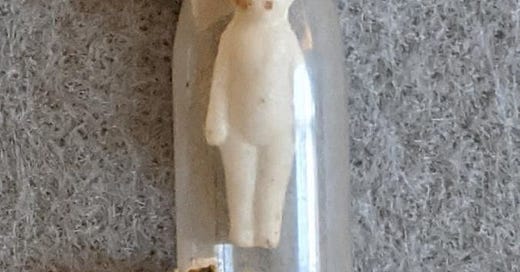Frozen Charlotte
Known as a “Frozen Charlotte” doll, this doll is porcelain and encased in a glass bottle, about 2” high. The bottle labels read “Night Blooming Cereus” and “Remember Me.” Chilling labels for a baby doll. This rather unusual collection item is actually a cautionary tale.
Its popularity is tied to a poem and a folk ballad. But it all started with a New York Observer newspaper article. Published Feb 8, 1840, the article reported about a woman who had frozen to death while traveling 20 miles in a sleigh to a New Year’s ball.
The story caught the public’s attention. A folk song titled, “Fair Charlotte” and a poem, “A Corpse Going to a Ball” by writer, Elizabeth Oakes Smith, helped to spread the tale.
The poem published in 1843 tells the sad tale of a vain young woman named Charlotte who ignored her mother’s warnings to dress warmly and froze to death while traveling to a New Year’s ball in an open sleigh. She chose to ride without blankets as they would cover her beautiful gown. When they got to the ball, Charles, her fiancé found her frozen body.
The song, "Fair Charlotte” was based on the poem and set to music in the late 1850’s by Vermont musician and folk singer, William Lorenzo Carter. The ballad became very well-known throughout the US and Canada.
The story of Frozen Charlotte captured imaginations of people because it had two important messages: don’t be vain and listen to your mother.
At this time, porcelain bath dolls were being introduced in the US. Made in Germany beginning in the 1850s, the porcelain dolls had a molded naked body with straight arms and legs. They were unglazed on the back and floated in the bathtub. They looked like small white corpses and were quickly nicknamed Frozen Charlotte.
Oddly, the Frozen Charlotte dolls were very popular. There were even male dolls made - Frozen Charlies. The dolls sold well because they were cheap. Children could collect them without much expense. The smaller versions were known as Penny dolls, as they could be bought with just a cent. The smaller dolls were often baked into celebration cakes as favors. It was considered good luck to get the cake slice with Frozen Charlotte.
The lesson of listening to one’s parents was strongly reinforced by the accessories that soon became attached to the little dolls such as their own blankets and metal caskets carved with words of warning, such as “Remember Me” on the label of the one in our collection. Others were packaged with their own little caskets.
Made in Germany and named in the US, the popularity of Frozen Charlotte dolls slowly faded during the early 1920s.
But they were a lesson learned – listen to your mother and dress warmly, it is cold outside!
Do you have a story you'd like to read, or a story to share? Please leave a comment or reach out to us. We'd love to hear from you!








